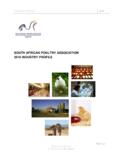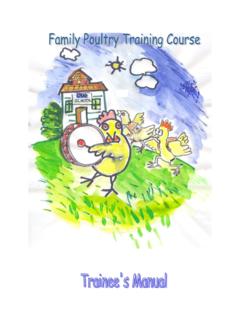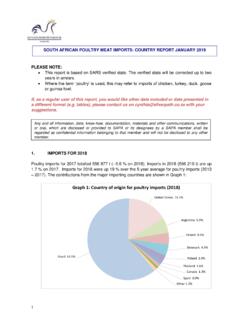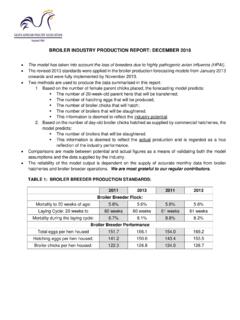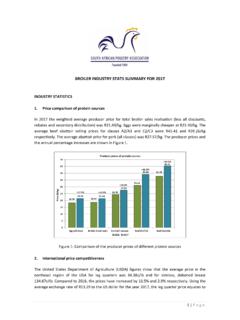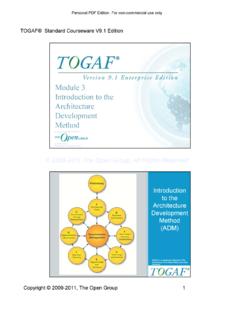Transcription of Learning Module 1 Layers Introduction to the …
1 SAPA LAYER NOTES Introduction TO THE SOUTH AFRICAN POULTRY FARMING INDUSTRY 1 Learning Module 1 Layers Introduction to the South African Poultry Farming Industry These notes were compiled by Professor James Hayes on behalf of the South African Poultry Association and are the property of the South African Poultry Association. Permission to use them can be obtained through SAPA SAPA LAYER NOTES Introduction TO THE SOUTH AFRICAN POULTRY FARMING INDUSTRY 2 SAPA LAYER NOTES Introduction TO THE SOUTH AFRICAN POULTRY FARMING INDUSTRY 3 1. THE POULTRY INDUSTRY IN SOUTH AFRICA Introduction After reading and studying these notes you will be able to see where your industry fits into the bigger picture of either poultry meat production or commercial egg production, you will be able to demonstrate an understanding of the origin of the present day breeds that are being used for meat and egg production as well as the supply chain for the production of meat and eggs.
2 You will also have the opportunity to familiarize yourself with the most popular housing systems used for poultry production. The poultry industry can be divided into two main divisions: Poultry meat production Pure meat-type breeds were used by overseas companies to develop lines with outstanding characteristics to put on weight fast and use feed efficiently Commercial egg production Pure egg-type breeds were used by overseas companies to develop lines with outstanding characteristics to put on weight fast and use feed efficiently Male and female White Plymouth Rock and male and female Indian Game White Leghorn male and female and New Hampshire male and female The development of lines: Males of one of the pure breeds, White Plymouth Rock, were mated (cross-bird) with females of the Indian Game breed to obtain a male line for meat-type birds. A female line was developed by mating females of the White Plymouth Rock with males of the Indian Game breed to serve as the female meat-type bird.
3 Nowadays these lines are called breeds and bear the names of their companies: Ross, Cobb, Arbor Acres, Hubbard etc. The very same procedures were followed by companies to develop the commercial egg-laying birds. These birds bear names such as Lohmann Silver, Lohmann Brown, Hy-Line and Amber-Link. The lines developed by the breeding companies by mating pure breeds are most valuable and are therefore maintained under very strict conditions of bio-security and remains the property of a particular company. Selection of the best performers is constantly taking place and only limited numbers of males and females, known as great-grand parents (GGPs), of either a meat-line or a commercial egg-line, will be sold to reputable organisations to use them as parents of breeding flocks (known as parent flocks) to produce hatching eggs from which chickens can be hatched and reared as either broilers or pullets for commercial egg production. SAPA LAYER NOTES Introduction TO THE SOUTH AFRICAN POULTRY FARMING INDUSTRY 4 Broilers is the term that is always used for meat-type poultry, they include males and females.
4 Broilers are reared from day-old to 33 - 35 days of age before being processed at an abattoir and the meat sold to supermarkets. Commercial Layers produce eggs that are sold in the supermarkets. Hens that produce fertile eggs for the production of day-old broilers or pullets for the table egg market are referred to as breeders. Some companies use the term breeder laying farm where females are mated with males to produce fertile eggs for day-old chicken production). The supply chain for poultry meat Broiler production An illustration in Figure 1 shows the involvement of different divisions of the broiler industry to ensure a constant supply of meat to the consumer. Figure 1 Supply chain for poultry meat The supply chain for production of eggs for the fresh egg market (table eggs) is in essence the same as the scheme in Figure 1 for the production of poultry meat. Instead of a hatchery for day-old broiler chickens one would find a hatchery for the production of day-old pullets1. 1 The term pullets is used for female chickens until they reach sexual maturity and start laying eggs Grandparent farms where the imported male and female lines are reared and where mating is done to produce parent stock laying farmsHatchery for hatching parent stock Males and femalesParent stock laying farmsBroiler rearing farmBroiler rearing farmBroiler rearing farmProcessing plantMeat packaging and distribution to marketsParent stock rearing farmsHatchery for day old broiler chickens from eggs produced on laying rearing farmSAPA LAYER NOTES Introduction TO THE SOUTH AFRICAN POULTRY FARMING INDUSTRY 5 Why a company does not share parent stock and broiler chick hatcheries.
5 1. The hatchery for the production of day-old chickens for broiler production delivers to a large number of rearing farms. Travelling to such farms by feed trucks and lorries during depopulation pose a high risk to contaminate equipment at their hatchery. 2. People and equipment can contaminate a parent stock hatchery which on turn will contaminate the breeding farms. This can result in a collapse in the supply chain of hatching eggs for the production of broilers for the market. The poultry meat and table egg industries Poultry industries worldwide are playing a huge role to supply mankind with high quality food as well as the means for people to make a living. Some of these aspects are summarized in Table 1. Table 1: Role of poultry to feed mankind Conversion of feed to food. Maize, soybeans, offal from animal industries, minerals, vitamins and many other products not readily acceptable by humans, are mixed and fed as balanced diets for broilers and Layers to produce meat and eggs.
6 Thus converting low quality products into highly nutritious food for mankind. Poultry meat is one of the best sources of protein for mankind. The low fat content of the breast meat, so-called white meat, is regarded as healthy meat. Eggs are the most balanced source of nutrients for humans. The proteins in eggs are used as standard against which all other proteins are evaluated in their ability to support growth in young animals and humans. It is also a good source of all vitamins and micro-minerals for healthy development as well as fats and oils as source of energy. Efficient converters of feed to food. Poultry, compared to cattle, has low energy requirements to maintain their own bodies and are therefore very efficient converters of feed to meat and eggs. That is why the price of these products has remained relatively low in relation to the cost beef and mutton. Consumption of poultry meat and eggs. Since 2010 more poultry meat was produced and consumed, kg per person per year, than the combined figure for beef, mutton and pork viz kg.
7 Consumption of eggs is 156 per person per year. Marketing of meat and eggs Marketing is done by the individual producers themselves and they would normally be under contract to supply a certain amount of meat or eggs over a certain period of time. The producer is thus under obligation to deliver their goods according to a specified program and this requires exceptional good planning to place orders for replacement stock, feed and packing material, transport etc. Health management of poultry flocks therefor needs to receive the highest priority to ensure a constant level of production of meat or eggs to satisfy demands from the consumer. SAPA LAYER NOTES Introduction TO THE SOUTH AFRICAN POULTRY FARMING INDUSTRY 6 Systems for meat and egg production Housing of broilers Structures vary a lot; from open-sided buildings to mechanically ventilated broiler sheds with insulated panels forming the side walls and roofs. The most important consideration for the latter type of construction is to save on fuel cost during the brooding period and to be able to cool buildings during hot summer conditions by means of extraction fans.
8 Providing optimum environmental conditions enable chickens to put on weight rapidly and they would reach a marketing weight of kg at 34 days of age. (Emergency generators in cases of power failures are an essential part of the operation.) On the other hand open-sided buildings with curtains that can be closed during brooding of day-old chickens and raised during warm weather are much cheaper to erect. Ventilation of these buildings, the so-called naturally ventilated buildings however, are dependent on air movement by wind. During summer mortalities might occur if no wind is blowing. Cost and efficiency of production play an important role when deciding on a particular type of housing. Normally broiler production is practiced under intensive conditions, in which the birds are confined to the inside of the building for the entire growing period. However, due to consumer demand, there are organizations that will allow the birds to move out of the building after the brooding period onto grassland, the so-called free-range system.
9 Pictures of the three types of buildings are shown below: Broiler house showing cooling pads on side wallCovered extractor fans on end wallMechanically ventilated broiler house with cooling padsNaturally ventilated broiler houseFree range broilersSAPA LAYER NOTES Introduction TO THE SOUTH AFRICAN POULTRY FARMING INDUSTRY 7 Housing of Layers Similar to the broiler industry housing of commercial Layers will be housed in two types of buildings: mechanically ventilated in which climate control is possible by means of extraction fans and cooling pads or naturally ventilated depending on air displacement by current winds. Pullets at point-of-lay are placed in battery cages at 17 to 18 weeks of age and will remain in production for approximately one year before being replaced by a new flock of point-of- lay pullets. The rearing of point-of- lay pullets2 is done specialist organizations to ensure that the correct lighting patterns are being followed and that the body mass at point-of- lay is according to the breed standards.
10 Similar to the broiler industry the production of eggs under a free range system is also very commonly practiced. Below: Inspection of hens in cages. 2 A pullet is the word used for a female bird from day-old to point-of-lay when she becomes a hen or a layer. Free range hens outside a laying house, inside view of Layers and nest boxesHigh rise building for Layers in cages on the right, note openings for removal of manure from side-openings Modern battery cage system with automatic egg LAYER NOTES Introduction TO THE SOUTH AFRICAN POULTRY FARMING INDUSTRY 8 The production cost of eggs under free range is higher because of the higher feed intake by hens due to the higher energy requirements for energy spent on walking. Table 2 Summary of terminology Eggs This product of the poultry industry is regarded as the most balanced source of nutrients for humans Broilers The term used for meat-type poultry slaughtered for meat Breeders Those birds that lay fertile eggs for day-old broilers or day-old pullets Hatcheries The places where chickens are hatched and they play an important role to maintain biosecurity in the supply chain of poultry meat and eggs Mechanically The term used for those broiler houses that are ventilated by electric fans Naturally This term describes the type of ventilation that depends on wind for air movement Pullets The word used for female birds from hatch to the point of lay SAPA LAYER NOTES Introduction TO THE SOUTH AFRICAN POULTRY FARMING INDUSTRY 9 South African Poultry Association The South African Poultry Association (SAPA)
